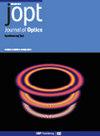Computational ghost imaging with adaptive intensity illumination for scenes featuring specular surfaces
IF 2.7
4区 物理与天体物理
Q3 OPTICS
引用次数: 0
Abstract
Imaging a target scene with specular surfaces is a daunting challenge for both direct imaging and indirect computational imaging techniques. The intense specular reflection component during the measurement severely degrades the quality of the reconstructed image, resulting in a substantial loss of scene information. To address this issue, we propose a computational ghost imaging (CGI) method with adaptive intensity illumination. Capitalizing on the encoded imaging feature of CGI, this method enables effective imaging of target scenes with specular surfaces through two series of measurements, eliminating the necessity for additional optical components. Based on the position and intensity information of pixels in the specular regions from the first series of measurements, our method modulates the illumination patterns to weaken the intensity of the specular region in the second series of measurements. Simulation and experimental results demonstrate that the utilization of these modulated illumination patterns for target scene measurement effectively mitigates interference from the specular surface during imaging. Consequently, the reconstructed image is capable of presenting more detailed information about the target scene other than the specular regions. Our work introduces a novel approach for imaging target scenes with specular surfaces and broadens the scope of applications for CGI in reality.利用自适应强度照明对具有镜面的场景进行计算鬼影成像
对于直接成像和间接计算成像技术来说,对带有镜面的目标场景进行成像都是一项艰巨的挑战。在测量过程中,强烈的镜面反射成分会严重降低重建图像的质量,导致场景信息的大量丢失。为了解决这个问题,我们提出了一种具有自适应强度照明的计算鬼影成像(CGI)方法。利用 CGI 的编码成像特性,该方法通过两个系列的测量对带有镜面的目标场景进行有效成像,无需额外的光学元件。根据第一轮测量中镜面区域像素的位置和强度信息,我们的方法在第二轮测量中调节照明模式,以削弱镜面区域的强度。仿真和实验结果表明,在目标场景测量中使用这些调制照明模式,可有效减轻成像过程中来自镜面的干扰。因此,重建后的图像能够呈现除镜面区域以外的更多目标场景详细信息。我们的工作为带有镜面的目标场景成像引入了一种新方法,拓宽了 CGI 在现实中的应用范围。
本文章由计算机程序翻译,如有差异,请以英文原文为准。
求助全文
约1分钟内获得全文
求助全文
来源期刊

Journal of Optics
OPTICS-
CiteScore
4.50
自引率
4.80%
发文量
237
审稿时长
1.9 months
期刊介绍:
Journal of Optics publishes new experimental and theoretical research across all areas of pure and applied optics, both modern and classical. Research areas are categorised as:
Nanophotonics and plasmonics
Metamaterials and structured photonic materials
Quantum photonics
Biophotonics
Light-matter interactions
Nonlinear and ultrafast optics
Propagation, diffraction and scattering
Optical communication
Integrated optics
Photovoltaics and energy harvesting
We discourage incremental advances, purely numerical simulations without any validation, or research without a strong optics advance, e.g. computer algorithms applied to optical and imaging processes, equipment designs or material fabrication.
 求助内容:
求助内容: 应助结果提醒方式:
应助结果提醒方式:


